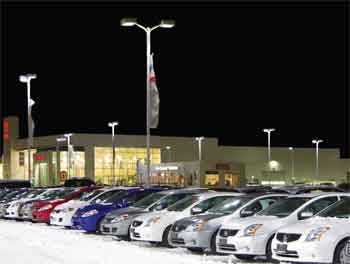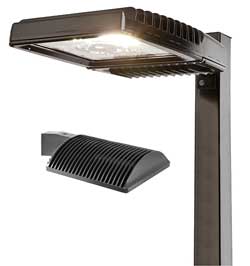LED lighting is quickly replacing many other options of the lighting market, and this trend isn’t going to stop anytime soon. If there’s one segment of the lighting market that is ground zero for the march of LED, though, it may be parking lot lighting. There is practically no downside to shifting to LED parking lot lighting, and there’s plenty of benefits. Better energy efficiency, longer lamp lifespan, greater durability, less weight, less maintenance – and the list goes on. The only challenge with making the shift to LED is the actual installation process.
What are the benefits of converting parking lot light fixtures to LED?
The first decision is whether to replace existing fixtures or retrofit them. There isn’t a single best answer in every circumstance. For some properties, bringing in new lighting poles, fixture heads and the like makes sense. For others, it is more cost-effective to switch out high intensity discharge (HID) fixtures for LEDs. So, when does it make sense to retrofit instead of replace?
- The property’s existing fixtures are new or in good condition – When a property owner chooses total replacement, it’s almost always because the existing fixtures were falling apart or failing, to an extent. HID fixtures are some of the oldest around, and it’s not uncommon for a property owner to overhaul their lighting technology when failures are too frequent to bear. If the fixtures are noticeably weathered, then full replacement may be a safer, more prudent option.
The other scenario that demands new fixtures is when setting up new construction. Obviously, there are no existing fixtures in this case, and investing in LED upfront will represent the best option.
However, if existing fixtures are relatively new or in good condition, there’s no reason to replace more than necessary. Retrofitting offers a cost-effective alternative in this instance and retrofit LED lamps provide the same benefits of new LED fixtures, without the need to make major changes to existing lighting.
- You’ve already invested heavily in your existing lighting – Some properties go all out in setting up aesthetically pleasing, soundly integrated lighting. The poles and heads go together well, there are extensive controls and sensors that keep everything running as efficiently as possible. In this case, it doesn’t make sense to reinvest in a completely new system.

Fortunately, that’s not necessary. Retrofit LED fixtures don’t require the property owner to change the way their existing poles or light heads look or operate. You get to keep the look and integration of the system, and get the benefits of LED lighting at the same time.
- Local government agencies may prohibit the installation of new fixtures – In some instances, it may not even be possible to place new fixtures. This is rare, but may be the case when the existing fixtures or the property is considered historic. And in other areas, new fixtures may be allowed, but the city or county requires a permit to set them, usually because they are concerned about potential loads. Such permits can be financially restrictive, making the decision to retrofit one that offers much better value. Retrofitting with LEDs will not require the purchase of a permit and will not affect the fixtures’ look or their long-term durability.
- A quick, simple installation is preferred – Setting up new fixtures, especially when new poles are required, takes additional expertise and time to accomplish. It’s common for new fixture installations to require two electricians, while retrofitting usually only requires a single expert. And once the electrician nails down the most effective way to install the mounting bracket and mount the LED, it can be handled in a matter of minutes. With enough retrofit kits, an entire parking lot full of LED lights can be set up in a single day.
It’s important to note that retrofit kits are full quality LED lights. They provide all of the same benefits of new LED lights, in that they provide superior efficiency, offer 50,000 to 100,000 hours of excellent performance, generate much less heat than HID lamps, are practically indestructible and can function for long stretches of time without maintenance. The decision between new and retrofit should not come down to a concern over fixture quality, because the difference is negligible. LED conversion kits, at least those worth considering, are ETL listed and will not adversely alter the UL status of an existing fixture. They are proven safe and reliable, in other words.
That said, there are a few things to keep in mind when selecting an LED conversion kit. For example:
- Consider the warranty attached to the kit – Some conversion kits only come with a three-year warranty, while some are paired with 10-year warranties. But when it comes to LED lighting, a longer warranty may be worth questioning. That’s because when an LED fixture fails, it is nearly always due to the driver giving out. And even the best quality drivers will experience hiccups after roughly five years of use. If the manufacturer is providing a 10-year warranty, does it cover the driver? Do you need to make an additional investment to protect that driver for longer? These are important questions to ask.
- Don’t select a kit based on wattage – Wattage is the energy required to power the lamp, and the lumen count is how much light the fixture outputs. When selecting a lamp, don’t only look at the wattage number, thinking that this is a shortcut for lamp intensity. It often isn’t. Instead, check both numbers, and consider how many lumens you’re getting per watt. This ratio is a shortcut in determining the fixture’s value, and if the ratio is less than 100 lumens per watt, it may not be the best option.
- Try to stay away from Mogul adapters – A Mogul adapter slots into an existing fixture’s socket and is intended to speed up the installation process. The problem with Mogul adapters, though, is that they are built to support a light bulb, not an LED conversion unit. A conversion unit weighs much more than a single lamp, often several times more. Relying on a Mogul adapter to anchor the fixture is asking for early failure and potential safety issues. Also, some rebates are only available if the fixtures are installed without Mogul adapters, which means the industry recognizes the poor compatibility between these adapters and fixtures.
Retrofitting HID parking lot lighting with LED technology is a cost-effective and quick way to improve efficiency, enhance reliability and position a property well going forward. And with modern conversion kits, transforming a property’s lighting is a realistic option for any property owner.






